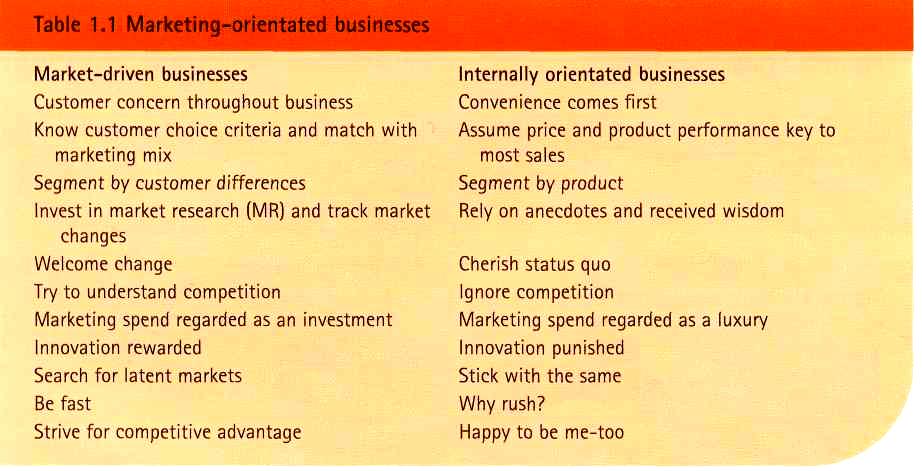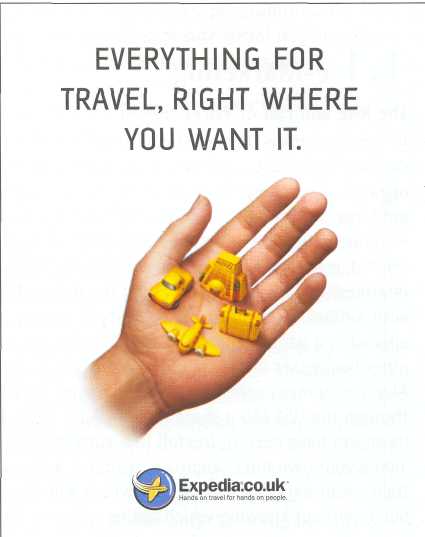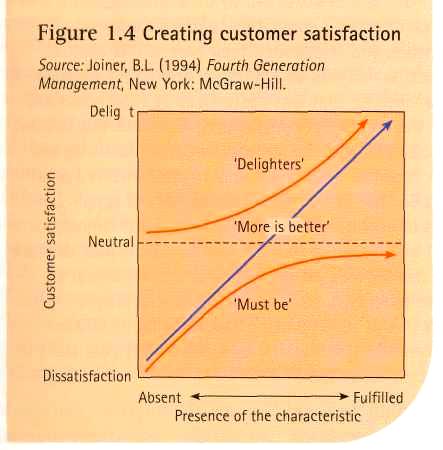
- •Міністерство освіти і науки україни
- •Кафедра іноземних мов
- •Сучасний Маркетинг
- •Донецьк - 2005 міністерство освіти і науки україни
- •Кафедра іноземних мов
- •Донецьк - 2005
- •К.П.Н., доц. ДонНу а.М.Шелестова,
- •Ббк 81.2 Англ - 923
- •Chapter 1. Marketing in the modern Firm Marketing Spotlight
- •The marketing concept
- •Marketing versus production orientation
- •The Rise and Fall of Priceline.Com
- •Creating customer value and satisfaction
- •Efficiency versus effectiveness
- •How Dell Computer Corporation Dominates the pc Market
- •Delivering customer value
- •The marketing mix
- •Product
- •Promotion
- •Bringing a Local Product to the Global Market
- •Ikea - International Expansion
- •Managing marketing activity
- •Marketing and business performance
- •Summary
- •Study questions
- •Appendix 1.1 Careers in marketing
- •Case 1 ‘Relighting the spark’- Can Marks & Spencer turn things around?
- •Questions
- •Chapter 2. The Marketing Environment m arketing Spotlight
- •Economic forces
- •Economic growth and unemployment
- •Development of the single European market
- •Scale building
- •Reorganization
- •Foreign investment
- •Central and Eastern Europe
- •Social forces
- •Pizza Express in Central Europe
- •Demographic forces
- •Marketing to 'Time-Poor' Consumers
- •Cultural forces
- •Corporate social responsibility and marketing ethics
- •Boots in Japan
- •The consumer movement
- •Political and legal forces
- •Monopolies and mergers
- •Restrictive practices
- •Codes of practice
- •Physical forces
- •Use of environmentally friendly ingredients
- •Recyclable and non-wasteful packaging
- •Protection of the ozone layer
- •Animal testing of new products
- •Pollution
- •Energy conservation
- •Internet Banking in Europe
- •Technological forces
- •Marketing via the Mobile Phone
- •Environmental scanning
- •Ignorance
- •Retrenchment
- •Gradual strategic repositioning
- •Radical strategic repositioning
- •Summary
- •Study questions
- •Case 2 European beef industry
- •The Common Agricultural Policy (cap)
- •Beef consumption patterns
- •A changing industry
- •Questions
- •Chapter 3. Understanding Customer Behaviour Marketing Spotlight
- •The dimensions of customer behaviour
- •Who buys?
- •Marketing to Children
- •How they buy
- •Need recognition/problem awareness
- •Information search
- •Web Shopping Made Easy- Price Comparison Websites
- •Evaluation of alternatives and the purchase
- •Post-purchase evaluation of the decision
- •Choice criteria
- •Influences on consumer behaviour
- •The buying situation
- •Personal influences
- •Information processing
- •Motivation
- •Beliefs and attitudes
- •Personality
- •Lifestyle
- •The Rise of the 'Mass Affluent'
- •Life cycle
- •Social influences
- •Culture
- •Social class
- •Reference groups
- •Influences on organizational buying behaviour
- •The buy class
- •The product type
- •The importance of purchase
- •Developments in organizational purchasing practice
- •Relationship management
- •Using the Internet to Improve Customer Service
- •Summary
- •Study questions
- •Case 3 Marketing software - Qumas
- •Integrated document management (idm) technology
- •Buyer behaviour issues
- •Challenges for Qumas
- •Questions
- •Chapter 4. Marketing Research and Information Systems Marketing Spotlight
- •Types of marketing research
- •Ad hoc research
- •Custom-designed studies
- •Omnibus studies
- •Continuous research
- •Consumer panels
- •Retail audits
- •The Ubiquitous Barcode
- •Television viewership panels
- •Approaches to conducting marketing research
- •Stages in the marketing research process
- •Initial contact
- •Research brief
- •Secondary research
- •Observation
- •The sampling process
- •Using the Internet as a Survey Method
- •Questionnaire design
- •Data analysis and interpretation
- •Data Mining
- •Report writing and presentation
- •Marketing information systems
- •Ethical issues in marketing research
- •Summary
- •Study questions
- •Appendix 4.1 Sources of European marketing information
- •Is there a survey of the industry?
- •Case 4 Green Isle's Goodfella's Pizzas
- •The consumer
- •The product
- •Imagery
- •Target market
- •Goodfella's success
- •Questions
- •Chapter 5. Market Segmentation and Positioning Marketing Spotlight
- •Making 'First-Class’ First Class
- •Segmenting consumer markets
- •Consumer segmentation criteria
- •Benefits sought
- •Purchase behaviour
- •Lifestyle
- •Smithwicks Focuses on Current Users
- •Social class
- •Geography
- •Segmenting organizational markets
- •Organizational segmentation criteria
- •Organizational size
- •Industry
- •Geographic location
- •Choice criteria
- •Purchasing organization
- •Segmenting the Web Audience
- •Segmenting the e-Learning Market
- •Target marketing
- •Evaluating market segments
- •Company capability
- •Target marketing strategies
- •Differentiated marketing
- •Focused marketing
- •Customized marketing
- •American Airlines Mass Customizes Using the Internet
- •Positioning
- •Perceptual mapping
- •Repositioning
- •Repositioning British Midland
- •Summary
- •Study questions
- •Case 5 Repositioning Skoda
- •Questions
- •Content
- •Marketing Spotlight………………………………………….……..154 Literature
The Rise and Fall of Priceline.Com
In the heady days of the dotcom revolution of the late 1990s, Priceline.com was one of the star companies. To many, this was a quintessential Internet company, one that turned the conventional wisdom of the 'old economy' on its head. Priceline's business proposition was that it allowed customers to bid for products. So if a person wanted to fly from Boston to San Francisco, for example, they would contact Priceline indicating when they wanted to fly and what price they were willing to pay. If Priceline accepted the bid, it then took it to the airlines to see if anyone was interested. In essence, Priceline was an intermediary or 'infomediary' using the power of the Internet to bring bargain-hunting customers together with airlines that had excess capacity. It quickly became apparent that this business model could be applied in a variety of sectors and Priceline expanded its 'name your own price' approach into a range of other businesses including hotel rooms, petrol, cars, telephone carriers, hardware products and even food. Along with many other dot.com companies, its share price soared as it grew and expanded, and it broke through the US$160 a share mark in April 1999. However, this was to prove its high point and, since then, its shares have been in freefall to a current (March 2002) level of just US$4. One of the problems with the 'name your own price' approach is that it asks a lot from customers. Bidders must submit the details of their credit cards with their bids, which will be charged if Priceline accepts their offers. But customers bid blind, without knowing which airline will take them to their destination, what time it will take off, or where they may have to change flights. It runs contrary to many consumers' desire for convenience, and assurances of quality and choice. So rather than being a service that appealed to a mass market as it was originally envisaged, it appears that what Priceline offers is limited to a niche group of price-sensitive consumers.
Creating customer value and satisfaction
Those companies that are marketing-orientated aim to create customer value in order to attract and retain customers. Their intention is to deliver superior value to their target customers and, in doing so, they implement the marketing concept by meeting and exceeding customer needs better than the competition. For example, Ritz Carlton has developed an enviable reputation in the luxury hotel market. One of the company's mottos is that staff 'only have permission to say yes'. This is a clear signal to everyone in the company that no effort should be spared in responding to the needs of their discerning customers. Customer value is dependent on how the customer perceives the benefits of an offering and the sacrifice that is associated with its purchase (see Exhibit 1.1). Therefore:
customer value = perceived benefits - perceived sacrifice
E xhibit
1.1 This
ad for expedia.co.uk, a travel website, highlights customer value;
the perceived benefits of information on products and services are
all available in one location (low perceived sacrifice)
xhibit
1.1 This
ad for expedia.co.uk, a travel website, highlights customer value;
the perceived benefits of information on products and services are
all available in one location (low perceived sacrifice)

The key to marketing success is to exceed the value offered by competitors. Consumers decide on purchases on the basis of judgements about the values offered by suppliers. Once a product has been purchased, customer satisfaction depends on its perceived performance compared to the buyer's expectations. Customer satisfaction occurs when perceived performance matches or exceeds expectations. Expectations are formed through pre-buying experiences, discussions with other people and suppliers' marketing activities. Companies need to avoid the mistake of setting customer expectations too high through exaggerated promotional claims, since this can lead to dissatisfaction if performance falls short of expectations.
In the current competitive climate, it is usually not enough simply to match performance and expectations. Expectations need to be exceeded for commercial success so that customers are delighted with the outcome. In order to understand the concept of customer satisfaction the Kano model (see Fig.1.4) helps to separate characteristics that cause dissatisfaction, satisfaction and delight. Three characteristics underlie the model: 'must be', 'more is better' and 'delighters'.

Those characteristics recognized as 'must be's' are expected and thus taken for granted. For example, in a hotel, customers expect service at reception and a clean room. Lack of these characteristics causes annoyance but their presence only brings dissatisfaction up to a neutral level. 'More is better' characteristics can take satisfaction past neutral and into the positive satisfaction range. For example, no response to a telephone call can cause dissatisfaction, but a fast response may cause positive satisfaction or even delight. 'Delighters' are the unexpected characteristics that surprise the customer. Their absence does not cause dissatisfaction, but their presence delights the customer. For example, a UK hotel chain provides free measures of brandy in the rooms of their adult guests. This delights many of its customers, who were not expecting this treat.
Over time, however, such 'delighters' become expected, and this is a problem that marketers must tackle. For example, some car manufacturers provided small unexpected delighters such as pen holders and delay mechanisms on interior lights so that there is time to find the ignition socket at night. These are standard on most cars now and have become 'must be' characteristics because customers expect them. This means that marketers must constantly strive to find new ways of delighting; innovative thinking and listening to customers are key ingredients in this.
